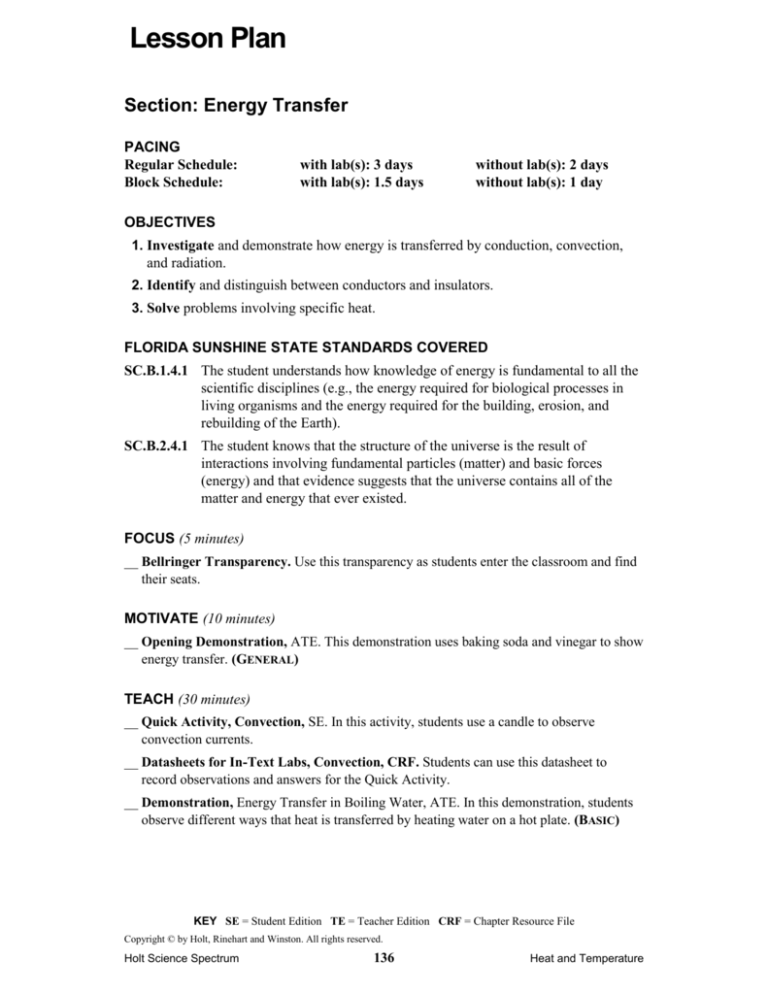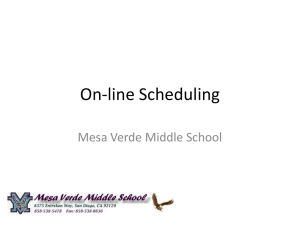
Lesson Plan
Section: Energy Transfer
PACING
Regular Schedule:
Block Schedule:
with lab(s): 3 days
with lab(s): 1.5 days
without lab(s): 2 days
without lab(s): 1 day
OBJECTIVES
1. Investigate and demonstrate how energy is transferred by conduction, convection,
and radiation.
2. Identify and distinguish between conductors and insulators.
3. Solve problems involving specific heat.
FLORIDA SUNSHINE STATE STANDARDS COVERED
SC.B.1.4.1 The student understands how knowledge of energy is fundamental to all the
scientific disciplines (e.g., the energy required for biological processes in
living organisms and the energy required for the building, erosion, and
rebuilding of the Earth).
SC.B.2.4.1 The student knows that the structure of the universe is the result of
interactions involving fundamental particles (matter) and basic forces
(energy) and that evidence suggests that the universe contains all of the
matter and energy that ever existed.
FOCUS (5 minutes)
__ Bellringer Transparency. Use this transparency as students enter the classroom and find
their seats.
MOTIVATE (10 minutes)
__ Opening Demonstration, ATE. This demonstration uses baking soda and vinegar to show
energy transfer. (GENERAL)
TEACH (30 minutes)
__ Quick Activity, Convection, SE. In this activity, students use a candle to observe
convection currents.
__ Datasheets for In-Text Labs, Convection, CRF. Students can use this datasheet to
record observations and answers for the Quick Activity.
__ Demonstration, Energy Transfer in Boiling Water, ATE. In this demonstration, students
observe different ways that heat is transferred by heating water on a hot plate. (BASIC)
KEY SE = Student Edition TE = Teacher Edition CRF = Chapter Resource File
Copyright © by Holt, Rinehart and Winston. All rights reserved.
Holt Science Spectrum
136
Heat and Temperature
Lesson Plan
HOMEWORK
__ Alternative Assessment, Interpreting the Opening Demonstration, ATE. Have students
answer 2 questions about the energy transfer in the opening demonstration. (BASIC)
__ Section Review, SE. Assign question 1 for homework. (GENERAL)
TEACH (35 minutes)
__ Quick Lab, What color absorbs more radiation?, SE. In this activity, students use
different-colored cans to to show how different colors absorb heat.
__ Datasheets for In-Text Labs, What color absorbs more radiation?, CRF. Students can
use this datasheet to record data, observations, and answers for the Quick Lab.
__ Quick Activity, Conductors and Insulators, SE. In this activity, students will investigate
how different materials conduct heat.
__ Datasheets for In-Text Labs, Conductors and Insulators, CRF. Students can use this
datasheet to record observations and answers for the Quick Activity.
__ Teaching Transparency, Specific Heat. Use this graphic to help students understand that
materials have different specific heat values.
__ Math Skills, Specific Heat, SE. This sample and practice-problem set teaches students
how to solve problems using the specific-heat equation. (GENERAL)
CLOSE (10 minutes)
__ Section Review, SE. Assign questions 2-5 for review. (GENERAL)
__ Quiz, ATE. Students answer 3 short-answer questions about energy transfer. (BASIC)
HOMEWORK
__ Math Skills, Specific Heat, CRF. This worksheet provides additonal samples and
practice problems for the specific-heat equation. (GENERAL)
__ Alternative Assessment, Conductors and Insulators in the Kitchen, ATE. Have students
classify different utensils in the kitchen as either insulators or conductors based on the
materials the utensils are made of. (BASIC)
LAB (45 minutes)
__ CBL Probeware Lab, Determining the Better Insulator for Your Feet, CRF. In this
lab, students compare the insulating qualities of different socks by calculating energy
transferred. (ADVANCED)
KEY SE = Student Edition TE = Teacher Edition CRF = Chapter Resource File
Copyright © by Holt, Rinehart and Winston. All rights reserved.
Holt Science Spectrum
137
Heat and Temperature
Lesson Plan
OTHER RESOURCE OPTIONS
__ Concept Review, CRF. This exercise reinforces the material covered in the section.
(GENERAL)
__ Spanish Concept Review, CRF. This worksheet helps reinforce English language
learners’ understanding of the main concepts presented in the chapter. (GENERAL)
__ Quiz, CRF. This quiz reviews the main concepts covered in the section. (BASIC)
__ Spanish Quiz, CRF. This quiz reviews the main concepts covered in the section. (BASIC)
__ Cross-Disciplinary Worksheet, Integrating Earth Science—Land and Sea Breezes,
CRF. Students will explore the connection between specific heat and the movement of
warm and cool air. (ADVANCED)
__ Alternative Assessment, Temperature Versus Energy, ATE. Have students conduct a
simple experiment to distinguish between temperature and energy. (BASIC)
__ SciLinks. Students can research Internet sources about the following topics with these
SciLinks Codes:
Energy Transfer, SciLinks Code HK4048
Insulators, SciLinks Code HK4073
Conduction, Convection, and Radiation, SciLinks Code HK4027
__ go.hrw.com Find resources and reference materials that go with your textbook at
go.hrw.com. Enter the keyword HK6 Home to access the home page for your textbook.
__ Guided Audio CD Program, Heat and Temperature. The audio program is a reading of
the chapter content for ELL students, auditory learners, and struggling readers.
__ Holt Online Learning. Students can access interactive problem solving help and active
visual concept development with the Holt Science Spectrum: Physical Science Online
Edition available at www.hrw.com.
KEY SE = Student Edition TE = Teacher Edition CRF = Chapter Resource File
Copyright © by Holt, Rinehart and Winston. All rights reserved.
Holt Science Spectrum
138
Heat and Temperature







